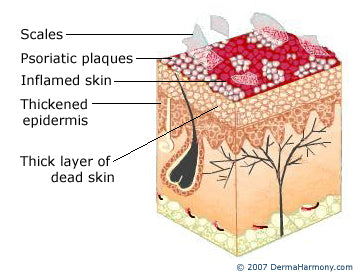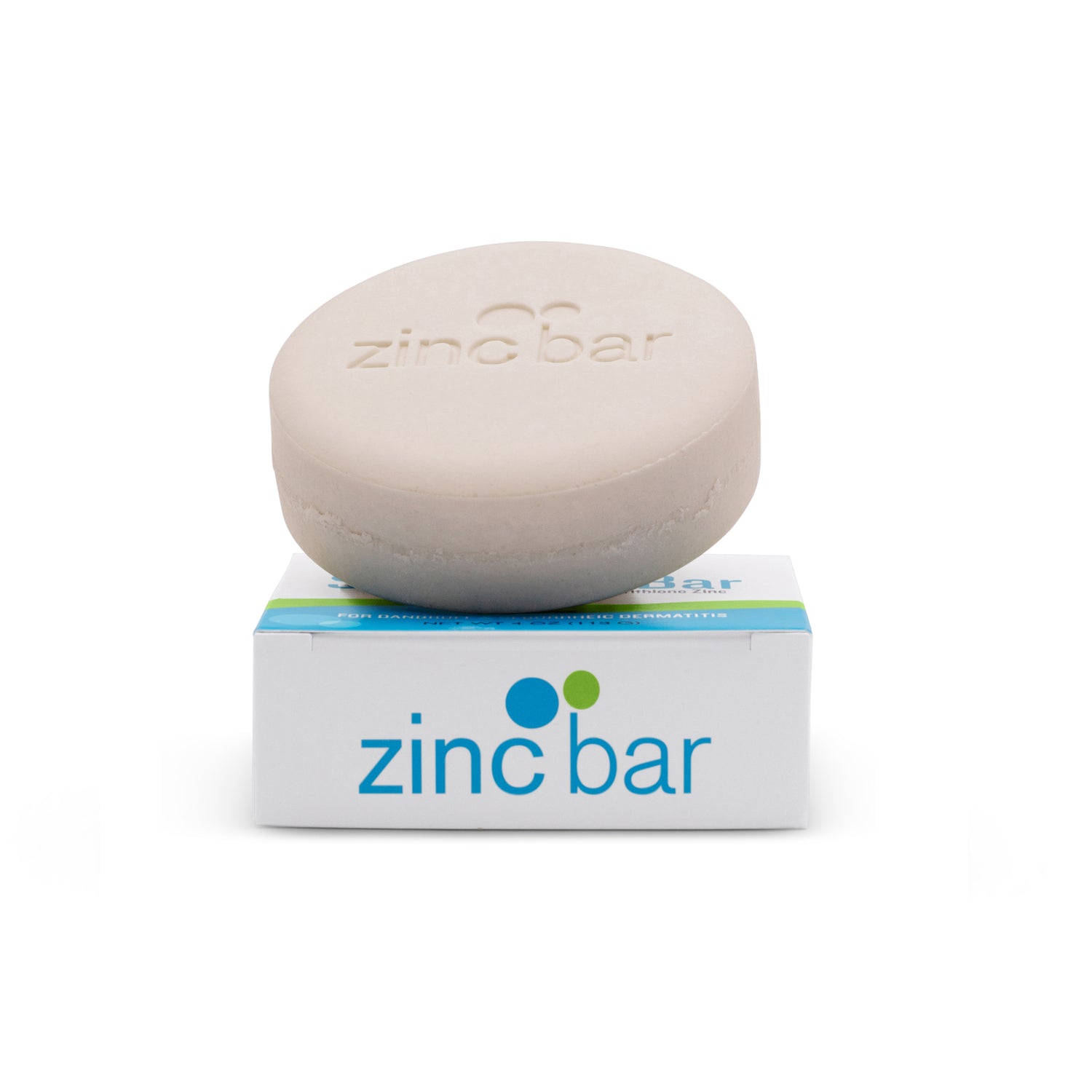Psoriasis
Psoriasis—Overview
Some say that psoriasis is the oldest known skin disease. While researchers are unsure if that is the case, one thing that is for certain is that people have suffered from psoriasis for a very long time. Many ancient texts, including the Bible, mention people afflicted with diseases and symptoms very much like Diagram of psoriatic skinpsoriasis. The Bible used the term tsaraat—an all-encompassing word for skin disease—in numerous passages. Ancient Egyptians wrote about a salve made with various herbs that would be spread on the skin, after which the afflicted person would be instructed to sit in the sun to bring relief to symptoms that seem to point to psoriasis.

Unfortunately, little was known about the origin of the disease for hundreds of years, and many psoriasis sufferers were thought at the time to have leprosy. Because so little was known about contraction and treatment, psoriasis patients were often separated from the general population for fear of their contaminating others. It wasn't until the early 1800's that psoriasis was determined to be a condition separate from leprosy. Soon after, the name psoriasis was given to the condition, stemming from the Greek word meaning "to itch."
After researchers began to study psoriasis as its own entity, they soon discovered that within the disease, there are multiple subsets.
- Plaque, or the most common type of psoriasis, is characterized by large patches of scaly, itchy thickened skin, or plaques, often covering large portions of the body. See image above.
- Affected by friction and sweat, flexural psoriasis most often presents itself as skin that is smooth but inflamed in the folds of skin under the arms, breasts, or around the genitals.
- The appearance of numerous, small, pear-shaped spots over the entire body following a streptococcal throat infection may be caused by guttate psoriasis.
- Postular (or pustular) psoriasis can either be concentrated in one area, such as the hands or feet, or spread over the body. The patches where it occurs are covered with small, pus-filled bumps that are often tender and painful.
- Thickening beneath either the toenails or fingernails, accompanied with change in the nails' appearance, such as lines or pitting of the nail, may be caused by nail psoriasis.
- Some who have psoriasis may also suffer from psoriatic arthritis, a condition that causes inflammation in the joints, most often those of the fingers and toes, but also afflicting other joints in the body or even the spine.
- Erythrodermic psoriasis is extremely dangerous, as most of the skin of persons with this condition is covered with painful itchy plaques, and the body is unable to regulate temperature and may be unable to protect itself from disease. This sometimes fatal form of psoriasis may be caused by volatile plaque psoriasis, especially if systemic treatment has been suddenly interrupted.
Psoriasis treatments
With so many different types of psoriasis and centuries of doctors studying them, there are a number of treatments available. Most advancements in psoriasis treatment have been made in the past century. Unfortunately, none of them are able to completely cure the disease, and some may cause significant side effects.
Pre 20th-century psoriasis treatment
As previously mentioned, herbal salves accompanied by sun exposure were methods used by ancient cultures to bring relief to skin disease. Another topical treatment commonly used for treatment is coal tar. Coal tar is applied to the skin in order to increase sun sensitivity. Not only is this method often very messy, but the tar can discolor the skin, and may cause inflammation of areas of skin not afflicted by psoriasis. Additionally, some studies have cited coal tar as a carcinogen.
20th-century psoriasis treatments
The 20th century saw a flurry of developments in psoriasis treatment. As years progressed the list of potential therapies grew, but for some, so did the list of harmful side effects.
In the 1920's, much of psoriasis treatment centered around sunlight exposure, particularly the effects of UVB rays on the disease. Most often the patient applied topical treatment or salve and was exposed to sunlight, much like in ancient times. Eventually a UVB lamp was developed to mimic the sun's rays and to provide a consistent wavelength.
Topical and oral steroids became a popular method of treatment during the 1950's, but also presenting a host of problems. These synthetic hormone-mimics are able to limit growth and inflammation of skin cells when applied to the skin. They work quickly, but need to be used often in order to retain results. Over time steroids can cause a number of problems, including cutaneous atrophy, and occasionally stretch marks develop which leave permanent scars.
Doctors in the 1960's began using hydroxyurea to treat psoriasis patients. This substance, also used in cancer treatment, is believed to inhibit the DNA replication within skin cells. Hydroxyurea may cause birth defects and can also cause a drop in white blood cells and platelets.
In the 1970's, interest in UV treatment for psoriasis was renewed. This time, however, patients were asked to use a method known as PUVA, or photochemotherapy. Psoriasis sufferers were given a medicine that made their skin more susceptible to light before being exposed to irradiation by UVA. This treatment not only causes premature aging of the skin, but also amplifies the risk of skin cancer.
Methotrexate, another cancer treatment, came onto the scene for psoriasis treatment in the 1990's. Methotrexate slows the growth of skin cells, but also slows the growth of other cells, such as bone marrow and sperm cells. Another potential side effect of this treatment is the potential for liver damage.
21st-century psoriasis treatments
In most recent years, a number of new treatments have become available for psoriasis patients. Some are based on older methods of treatment, but some, like biological therapies, are new to the field of medicine altogether.
Lasers have become a new way for psoriasis sufferers to deal with flare-ups. Much in the same way that lasers are used to alleviate the signs of aging or redness, areas of skin affected by psoriasis lesions are targeted by a beam of intense UV light. This method of treatment is suggested only to those with mild cases, and occasionally scarring may occur.
A treatment which is new for psoriasis as well as in the medical community is the administration of biological therapies. Biological therapies are injected into patients suffering from more advanced psoriasis symptoms. Biologicals target and block specific immune cells within the body. Several biological treatments are currently available, and more are in development. Currently they appear to be a relatively safe treatment method, yet studies are still being conducted to determine potential side effects.
Cyclosporin, tioguanine, and retinoid drugs are just a few of the systemic treatments offered to treat severe psoriasis cases. Cyclosporin works by suppressing the immune system, while tioguanine, which is often used to treat leukemia, prevents cell growth and division. Retinoids are very potent synthetic forms of vitamin A. Due to the high toxicity and side effects of these medications, patients must be monitored frequently for distress in the liver and kidneys, and women using this method of treatment are discouraged from becoming pregnant during treatment due to high risk of birth defects.
The DermaHarmony approach to psoriasis treatment
Even with multiple options, there is currently no cure for psoriasis. Many of the aforementioned treatments are available only to those with very acute outbreaks, and some may cause harsh side effects. Although not directly caused by allergies, psoriasis can be aggravated by an individual's exposure to allergens as well as increased inflammation in the body. At DermaHarmony we believe that relief may be possible by reducing stress, implementing drastic changes in diet, practicing regular detoxification, and ensuring proper supplementation.

Consider for a moment the stages of psoriasis and treatment as rungs on a ladder. The first rung represents the sufferer with very light symptoms, perhaps even in remission. As the rungs increase, so does the severity of both the condition and treatment. Some researchers such as Dr. John Pagano, a chiropractic doctor and author of Healing Psoriasis—the Natural Approach, believes that internal toxicity is a major factor in the cause of psoriasis outbreaks. Unfortunately, some of the very aggressive forms of treatment can damage the liver and kidneys, the very organs responsible for controlling toxicity in our bodies. If steps can be taken for psoriasis sufferers to keep the condition under control and stay on the "first rung" of the ladder, they may be able to enjoy relief for longer periods of time without the perils of harsher treatments. You may be surprised to learn that lifestyle changes can have the same effectiveness as systemic treatments, but without the high cost and toxic long-term implications
DermaHarmony believes in healing the body from the inside out. This means cleansing and detoxifying the system to help prime the liver and ready the intestines for maximum supplement absorption. We also suggest a healing diet for psoriasis and taking pharmaceutical-grade supplement packages to help support your body in the healing process. You may also want to consider supplementing with doses of additional vitamin D, which may increase your ability to relieve psoriasis symptoms.
Through optimal supplementation, detoxification, and increased awareness of factors like diet and stress, we are hopeful that you can find additional relief from the pain and distress so often associated with psoriasis. Learn more about how DermaHarmony can help psoriasis through detoxification and diet.

